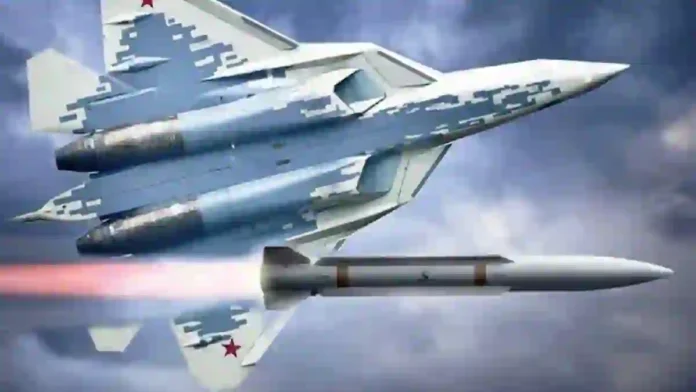In a twist of strategic irony, India, which withdrew from the Fifth Generation Fighter Aircraft (FGFA) program with Russia in 2018 over concerns about the Su-57’s underwhelming stealth and super cruise capabilities, is now looking at acquiring the same aircraft.
India is examining the possibility of procuring at least two squadrons of Su-57 aircraft from Russia and will evaluate a Russian proposal to manufacture them in India like the earlier MiGs and the Su-30MKI, according to ThePrint.
Read- India’s Aircraft Carrier Plan Hit by US Tech Delays: US Betraying Indian Navy?
The Sukhoi Su-57 stealth fighter is poised to play a crucial long-range strike and multi-role combat role for the Indian Air Force (IAF). Unlike a pure stealth-centric fighter, the Su-57 offers a blend of significant payload capacity, advanced beyond-visual-range missile capabilities, and super-manoeuvrability, making it a complementary asset alongside India’s existing fleets such as the Rafale and Su-30MKI.
India is likely to assign the Sukhoi Su-57 squadrons several key mission profiles aligning with the aircraft’s strengths in multi-role, long-range strike, and beyond-visual-range (BVR) combat capabilities.
Firstly, the Su-57 will serve as a long-range strike platform, tasked with deep penetration missions into adversary territory. Its large internal weapons bay and extended range make it ideal for delivering precision-guided munitions like the hypersonic Kinzhal missile against high-value and heavily defended strategic targets, thus expanding India’s ability to conduct surgical strikes far beyond the frontline.
Secondly, the Su-57 squadrons will operate in a dominant BVR air superiority role. With integration of the powerful R-37M air-to-air missile, capable of engaging enemy aircraft at ranges beyond 300 kilometres, these fighters will neutralise aerial threats before close combat ensues, enhancing the IAF’s stand-off engagement capabilities against hostile fighter aircraft, including potential stealth platforms.
Read- L&T Forms Strategic Partnership With BEL For India’s AMCA 5th-Generation Fighter Aircraft Program
Read- India Successfully Tests Agni-Prime Missile From Rail-Based Mobile Launcher
A complementary mission will include providing escort and protection to other strike aircraft such as the Rafale and Su-30 MKI during complex operations, leveraging the Su-57’s multi-sensor fusion and network-centric warfare capabilities to maintain air dominance while allowing other platforms to execute their strike or reconnaissance missions.
Furthermore, the Su-57 may support maritime strike roles, holding key enemy naval assets at risk by deploying long-range anti-ship missiles. This adds a maritime dimension to India’s air combat strategy, synergising with the Indian Navy’s operational plans and enhancing joint force capabilities.
Finally, Su-57 squadrons will fill immediate operational needs as a stop-gap fifth-generation stealth fighter capability until India’s indigenous AMCA stealth fighter becomes operational. This makes the aircraft a strategic bridge to a more technologically autonomous future air force.
A key advantage the Su-57 brings to the IAF is its ability to carry very long-range missiles like the R-37M air-to-air missile, which has an engagement range exceeding 300 kilometres.
This capability provides the IAF with unprecedented beyond-visual-range firepower to neutralise aerial threats before they become immediate dangers. Additionally, it can deploy the hypersonic air-launched ballistic missile Kinzhal, enhancing India’s precision strike options against high-value and distant targets with great speed.
The aircraft’s design emphasises a combination of stealth, super-manoeuvrability, and large internal weapons bays. Its extensive payload capacity internally housed preserves stealth characteristics while enabling it to conduct deep strike missions effectively.
The Su-57’s range and ordnance capabilities fill a critical gap in the IAF’s arsenal by extending the reach and lethality of India’s combat operations well beyond the frontlines.
India’s consideration of the Su-57 also includes potential joint manufacturing arrangements with Hindustan Aeronautics Limited (HAL), following Russia’s offer to collaborate on local production. Such cooperation could provide India access to advanced aircraft technology and sustainment capabilities, reinforcing its strategic autonomy in defence preparedness.
Although India had withdrawn earlier from the joint FGFA fifth-generation fighter project with Russia due to concerns over costs, performance, stealth limitations, and technology transfer, the renewed interest in the Su-57 stems from evolving regional security dynamics and an urgent need to enhance long-range strike and air combat capabilities. The acquisition would serve as a stop-gap solution while India advances its indigenous stealth fighter programs.
The key role of the Su-57 for the Indian Air Force is to act as a powerful multi-role stealth fighter with a focus on long-range strike missions, beyond-visual-range air dominance, and complementing existing fighter fleets.
Its integration into the IAF will boost India’s strategic reach, air combat effectiveness, and operational versatility in a rapidly shifting regional security environment.
IDN (With Agency Inputs)
Agencies




